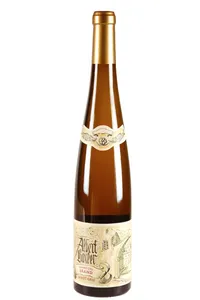Free delivery from Fr. 300 of purchase or 18 bottles, otherwise Fr. 15

Alsace
You can't get enough of bucolic Alsace, its villages and half-timbered houses, its storks, its hilly landscapes, its art of living, taking time and savouring it. A pioneer in wine tourism, with fantastic assets and a gastronomy that is both traditional and innovative, Alsace attracts thousands of tourists every year. The wines, in their own way, reflect this diversity, this abundance, these contradictions and also these ruptures. Behind what can often appear to be a cliché, one must search for the truth, which is often plural. Alsace is searching for itself and deserves our full attention. Endowed with a real geological mosaic, between wines of the soil, of places and of grape varieties, Alsace sometimes seems to hesitate. Most of the vineyard - which from Strasbourg to Mulhouse covers an area of more than 15,000 hectares, most of which is located on a strip of sub-Vosgian slopes - is essentially devoted to the production of white wines. It should be noted that this represents nearly 30% of all French white wines. A pioneer in biodynamic viticulture, Alsace can now boast of being the only vineyard in France where a quarter of the vineyard is cultivated biodynamically (the practice here dates back more than half a century). However, the quality is far from being homogeneous: on the one hand, among the 3900 Alsatian wine growers, an elite which, taking advantage of an exceptional mosaic of terroirs, chisels wines of great class; on the other hand, a viticulture still too centred on the yield and the varietal wines. As far as the latter are concerned, seven are authorised in the production area: Riesling, Pinot Blanc, Gewurztraminer, Sylvaner, Pinot Gris, Muscat and Pinot Noir. This range of grape varieties results in an astonishing diversity of flavours and, in the case of the terroirs with the highest viticultural potential, allows the soil-variety-micro-climate synergy to be explored in depth. The expression of a given grape variety is indeed variable, depending in particular on the geological data. The fifty-one Alsatian "Grands Crus", for example, are located on very different geological formations, a dozen in all, from clayey-marl-gypsum (Schoenenburg) to pure limestone (Furstentum or Rosacker), to marl-limestone (Altenberg de Bergheim and Wolxheim), to marl-limestone-sandstone (Geisberg, Kirchberg or Vorbourg), via granitic (Brand or Sommerberg), sandstone-volcanic (Muenchberg), shale (Kastelberg) or volcano-sedimentary (Rangen de Thann).
31 items

Pinot Gris Grand Cru Brand, Albert Boxler - 2018
Alsace

Langenberg, Marcel Deiss - 2018
Alsace

Burg, Marcel Deiss - 2016
Alsace

Riesling, Clos Mathis, Ostertag - 2021
Alsace

Riesling, Muenchberg Grand Cru, Ostertag - 2021
Alsace

Pinot Gris, Muenchberg A360P, Ostertag - 2020
Alsace

Riesling, Muenchberg Grand Cru, Ostertag (magnum) - 2021
Alsace

Riesling Grand Cru Sommerberg, Albert Boxler - 2021
Alsace

Riesling Grand Cru Sommerberg "D", Albert Boxler - 2021
Alsace

Riesling Grand Cru Sommerberg "E", Albert Boxler - 2021
Alsace

Pinot Gris Grand Cru Brand, Albert Boxler - 2019
Alsace

Schoenenbourg Grand Cru, Marcel Deiss - 2017
Alsace